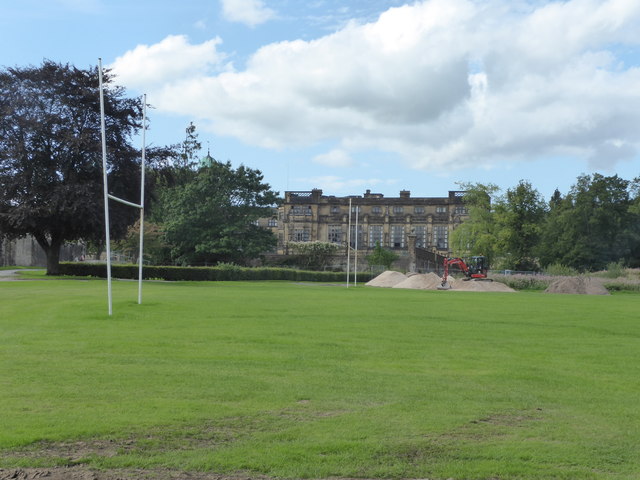Stonyhurst College seen across the rugby pitches
Introduction
The photograph on this page of Stonyhurst College seen across the rugby pitches by Marathon as part of the Geograph project.
The Geograph project started in 2005 with the aim of publishing, organising and preserving representative images for every square kilometre of Great Britain, Ireland and the Isle of Man.
There are currently over 7.5m images from over 14,400 individuals and you can help contribute to the project by visiting https://www.geograph.org.uk

Image: © Marathon Taken: 30 Aug 2018
The earliest building at Stonyhurst was probably there in the 13th century, and added to during the 13th and 14th centuries. Around 1590 Richard Shireburn embarked on the creation of a new Elizabethan house, which was not completed for a further 250 years. Oliver Cromwell who stayed here on his way to the Battle of Preston in 1648 called Stonyhurst "the best half house" he had seen. The Shireburns were staunch Catholics and remained loyal to King Charles I in the Civil War. Sir Nicholas Shireburn, who died in 1717, was the last of the Shireburns to live at Stonyhurst. In 1754, Stonyhurst passed to the Welds of Dorset, who never occupied the house and it was allowed to fall into a state of decay. In 1794, the Welds placed Stonyhurst at the disposal of the Jesuit English College at Liege who had fled from the advancing French Revolutionary army and Stonyhurst became a boarding school for Catholic boys. The church of St Peter's was built by the 1850s and the front quadrangle completed. During the 1880s, the South Front was greatly extended and Stonyhurst had become one of the foremost public schools in the country. J.R.R. Tolkien spent much of his time at Stonyhurst working on 'The Lord of the Rings'. The trilogy was compiled over 16 years and finally published in 1954/5. J.R.R. Tolkien, his wife and children regularly stayed at a guest house in the grounds belonging to the college. Here the college is seen from the footpath through the grounds.

